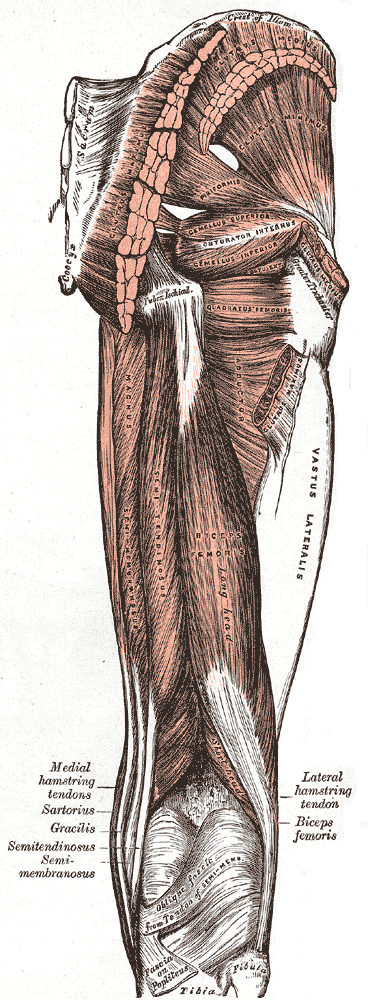The knee joint allows for movement of the lower leg relative to the thigh across the knee joint. The knee joint is in fact comprised of two joints: the tibiofemoral joint between the femur and tibia, which is the weight-bearing knee joint, and the patellofemoral joint, which joins the patella (kneecap) with the femur.
The tibiofemoral joint is relatively weak and easily damaged, so it relies on muscles and ligaments to ensure stability . When the knee is fully extended the femur rotates slightly on the tibia to lock the joint into place, allowing for efficient load bearing.
The patella is the attachment point for the quadriceps femoris muscle and is the attached by a ligament to the tibia. This increases the leverage afforded to the quadriceps femoris muscle, thus increasing its efficiency when extending the lower leg. The patella additionally protects the knee joint from damage.
The patellofemoral has two key functions: increasing leverage of the quadriceps tendon to improve muscle stability and protecting the knee joint from damage.
Muscles that generate movement across the knee are mainly located in the thigh and can be split into anterior and posterior compartments. The popliteus muscle, located in the lower leg, is responsible for “unlocking” the knee joint after extension.
Anterior Muscles of the Thigh
There are four muscles in anterior region of the thigh. The pectineus and iliopsoas muscles are responsible for movement at the hip and are discussed elsewhere.
Sartorius - The sartorius, a thin muscle in the thigh, the is the body's longest muscle.
- Attachments: Originates from the pelvis and attaches to the tibia.
- Actions: Flexing of the lower leg at the knee joint.
Quadriceps Femoris – The quadriceps femoris is actually composed of four muscles that comprise the front of the thigh: three deep-lying vastus muscles (lateralis, intermedius, and medialis) and the rectus femoris which covers them. All four muscles are the key extensors of the lower leg at the knee joint and also stabilize and protect the patella.
- Attachments: The vastus lateralis, intermedius, and medialis originate from the femur and attach to the patella. The rectus femoris originates from the pelvis and attaches to the patella.
- Actions: Extends the lower leg at the knee joint and stabilizes the patella. The rectus femoris additionally facilitates rotation at the hip.
Posterior Muscles of the Thigh
There are three muscles in the posterior compartment of the thigh: the biceps femoris and two synergistic muscles (the semitendinosus and semimembranosus). These muscles are sometimes termed the hamstring group. The posterior region of the thigh displays similarity with the anterior region of the upper arm in both structure and function.
Biceps Femoris – A similar muscle to the biceps brachii in the upper arm and also double-headed. Two synergistic muscles are associated with the biceps femoris, the semitendinosus and the semimembranosus.
- Attachments: Originates from the pelvis and femur and attaches to the fibula.
- Actions: Extends and laterally rotates at the hip, main action is flexing of the lower leg at the knee.

Posterior muscles of the thigh
The biceps femoris and synergistic semitendinosus and the semimembranosus muscles are responsible for flexing of the lower leg at the knee.
Other Muscles
Popliteus - The popliteus is located behind the knee joint and acts to “unlock” the knee by rotating the femur on the tibia allowing for the lower leg to be flexed.
- Attachments: Originates from the posterior of the tibia and attaches to the femur.
- Actions: Laterally rotates the femur on the tibia “unlocking” the knee joint so that flexion can occur.

Muscles of the posterior region of the lower leg.
Posterior view of muscles of the lower leg, the popliteus can be seen at the top located behind the knee.
Key Movements
Extension
- Produced by the sartorius and quadriceps femoris group of muscles.
Flexion
- Produced by the biceps femoris, semitendinosus, and semimembranosus muscles. The popliteus muscle facilitates this movement by unlocking the fully extended knee joint.
Rotation
- The knee joint allows for slight rotation when flexed, which is produced by the biceps femoris, semitendinosus, semimembranosus, gracilis, and sartorius.